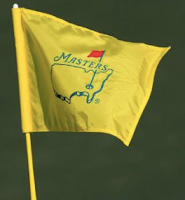A Tradition That’s Totally, Way, Way Different From All the Other Ones
 Like most sports fans, I’m tuning in this week to watch some golf as the 78th annual Masters Tournament plays out in Augusta, Georgia. Kind of weird how in this era of comprehensive coverage they actually limit the number of hours the TV folks can show, but since I’m not such a hardcore fan it doesn’t bother me much.
Like most sports fans, I’m tuning in this week to watch some golf as the 78th annual Masters Tournament plays out in Augusta, Georgia. Kind of weird how in this era of comprehensive coverage they actually limit the number of hours the TV folks can show, but since I’m not such a hardcore fan it doesn’t bother me much.I’m not a golfer, myself. Sure, I played miniature golf as a kid, and in grad school went a couple of dozen times to the Par 3 course the university had. There was a regular “championship” course, too, which I think I only played once. Had a lot of fun playing, getting enough of a taste to realize the game is a lot, lot harder than it sometimes looks.
To be honest, I’m not sure why I find golf interesting to watch, but I do.
As a sports fan, generally speaking, I’m probably just gravitating toward the next major event on the sports calendar when I tune into the Masters. That is to say, I don’t really pay much attention to non-major tournaments, although will occasionally tune in on a Sunday to catch the conclusion of whatever happens to be playing out.
I’m curious about Tiger Woods and his comeback, of course. And phenom Rory McIlroy’s fourth-round flame-out at last year’s Masters and subsequent victory at the U.S. Open makes him one to watch. A few other players -- Luke Donald, Phil Mickelson, Bubba Watson, Fred Couples -- kind of stand out, too.
But to be honest I don’t really need those guys’ participation or the various storylines they bring to be interested. The tournament will produce its own narrative, and by Sunday I’ll be curious to watch no matter who is up high on the leaderboard vying for the title.
I think about how successful golf is at attracting non-players and casual fans, especially for major tourneys like the Masters. A study from a couple of years ago determined there were 28.6 million golfers in the U.S. (aged six and above). Last year there were an estimated 42.3 million viewers tuning in for some or all of the weekend coverage of the Masters on CBS.
In other words, a lot of people are watching golf who don’t play.
 Meanwhile, there are apparently 60 million poker players in the U.S. That’s the number that gets repeated a lot anyway, including in the new documentary All In: The Poker Movie, which mentions that figure as representing the number of folks playing poker every week in 2011.
Meanwhile, there are apparently 60 million poker players in the U.S. That’s the number that gets repeated a lot anyway, including in the new documentary All In: The Poker Movie, which mentions that figure as representing the number of folks playing poker every week in 2011.But when it came the WSOP being aired on ESPN last fall, those tuning in from week to week generally numbered well under 1 million, sometimes not even 500,000. I know the “almost live” coverage of the Main Event back in July drew similar totals, peaking around 650,000 or so. I believe the November Nine stuff also hovered around the 1 million-mark, although I can’t put my finger on exact numbers.
So, obviously, a lot fewer watch poker than golf. And of those who do watch poker, I’m going to guess there are very, very few who aren’t players themselves.
I know, it’s apples and oranges. Actually it’s more like apples and orangutans, golf and poker being so very different from one another. Furthermore, there are tons of reasons why golf works better on the tube than does poker.
Still, it’s interesting to think about why the Masters can get a non-golfer like me interested, while poker is so much of a harder sell to the non-player.
Labels: *the rumble, golf, Rory McIlroy, Tiger Woods














1 Comments:
Some of the appeal for the Masters to non-golfers might be watching people do extraordinary things that 99.99% of the rest of us can't do. The perception (rightly or wrongly) is different in poker; it's easier for the common person to believe that poker is mostly luck and that anybody can knock out Phil Ivey.
Post a Comment
<< Home